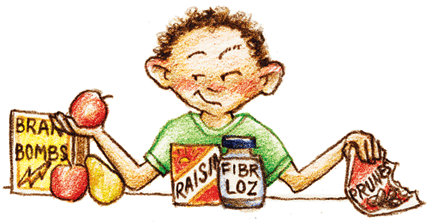Constipation in Toddlers
and School-age Children
Lisa Buenger, MD
Pediatrics
Oak Leaf Pediatrics, Eau Claire
Approximately 30% of U.S. children (toddler to school-age) experience constipation, which is defined as stool that is infrequent or hard and/or difficult to pass. When your child has painful, infrequent stools or soiling accidents, constipation is the likely cause. The term soiling refers to the passage of liquid stool around a build up of larger stool in the rectum. When a child has had constipation for even a couple weeks, accumulation of stool in the rectum leads to stretching and decreased sensation in the muscles and nerves that tell the child he needs to have a bowel movement. The longer this is present the more likely the child will be unable to recognize both the need to stool or stop any leakage. If the child had a painful experience in the past he will then begin to avoid stooling to prevent it from hurting again. This causes the constipation to continue to worsen.

Additional symptoms of constipation in children include abdominal pain, especially after eating, decreased appetite, nausea, or posturing to prevent stooling by standing up straight and squeezing his legs together. Parents may confuse this posture as struggling to pass the stool when actually he is “holding it in.”
It is important that the child have a medical evaluation as soon as constipation has been present for a couple weeks. The longer the symptoms last, the more difficult to achieve regular toileting habits. Over 50% of constipated children recover after 6 to 24 months of carefully monitored treatment. Treatment involves four stages beginning with removing the excess stool, often using a combination of laxatives, enemas or stool softeners. The laxatives help push the stool through the intestines and the enemas remove impacted stool from the bottom to prevent cramping.
Constipation treatment consists of
- Clean-out
- Maintenance
- Behavioral changes
- Dietary changes
Once excess stool has been removed, the maintenance phase begins with the goal to keep all stools soft, frequent and non-painful. This phase may last many months, to shrink back the stretched out rectum and retrain the muscles.
Behavior and dietary changes are vital to recovering from constipation. Record all stools on a chart. Try to schedule regular meals and decrease snacking to allow a natural reflex to stool after meals. Designate multiple times in the day to sit on the toilet for 5 minutes. Most children are too busy to “wait” and need to be reminded to try to have a bowel movement. Use rewards for stooling, avoid punishment and let them know what you expect. For young children, a statement such as “The poop wants to come out and go down the waterslide” often receives a giggle and decreases the tension. “Did I hear a toot?” often gets a smile and the child then tries to pass gas for fun (which gets her pushing). Good high fiber food choices include:
Raspberries, dried prunes, pears, blueberries, raisins, apples with skin,
oranges, strawberries, beans such as baked, pinto or lima, potatoes with skin
and pumpkin.
Dietary Management
Include daily grams of fiber to equal the child’s age in years +5 to 10. Example: A 3 year old should consume 8-13 grams of fiber daily. Check the fiber content of cereals, breads and pastas. Choose those that say
whole grain and have more fiber. Encourage a naturally colorful diet. Over-the-counter fiber supplements are available.Ensure adequate daily fluid intake: approximately 30 oz, if child weighs 20 lb; 50 oz., if 40 lb Decrease constipating foods such as jello, rice, bananas, junk food and crackers. Dairy products should not be given in excess. Check with your provider to see how much your child needs.
Websites helpful for picky eaters:
familyfun.go.com/recipes/kids/
www.nickjr.com/food/kids_nutrition/picky_eaters_update.jhtml
Constipation may develop as a result of any number of normal causes
• Painful stools in the past or fear of using the toilet
• Diets high in constipating foods and low in fiber
• Medications
• Infections leading to dehydration
• Lack of time for toileting routines
• Developmental features
• A family pattern of slow bowel movements
95% of children with constipation have no underlying pathologic condition.
Constipation needs to be addressed if it is discovered to persist more than a couple weeks. Don’t wait to make changes or to contact your doctor. The longer it is before treatment, the longer until recovery.
For more information on children’s constipation or to schedule an appointment with Dr. Buenger, OakLeaf Pediatrics, Eau Claire, contact 715-830-0732.



